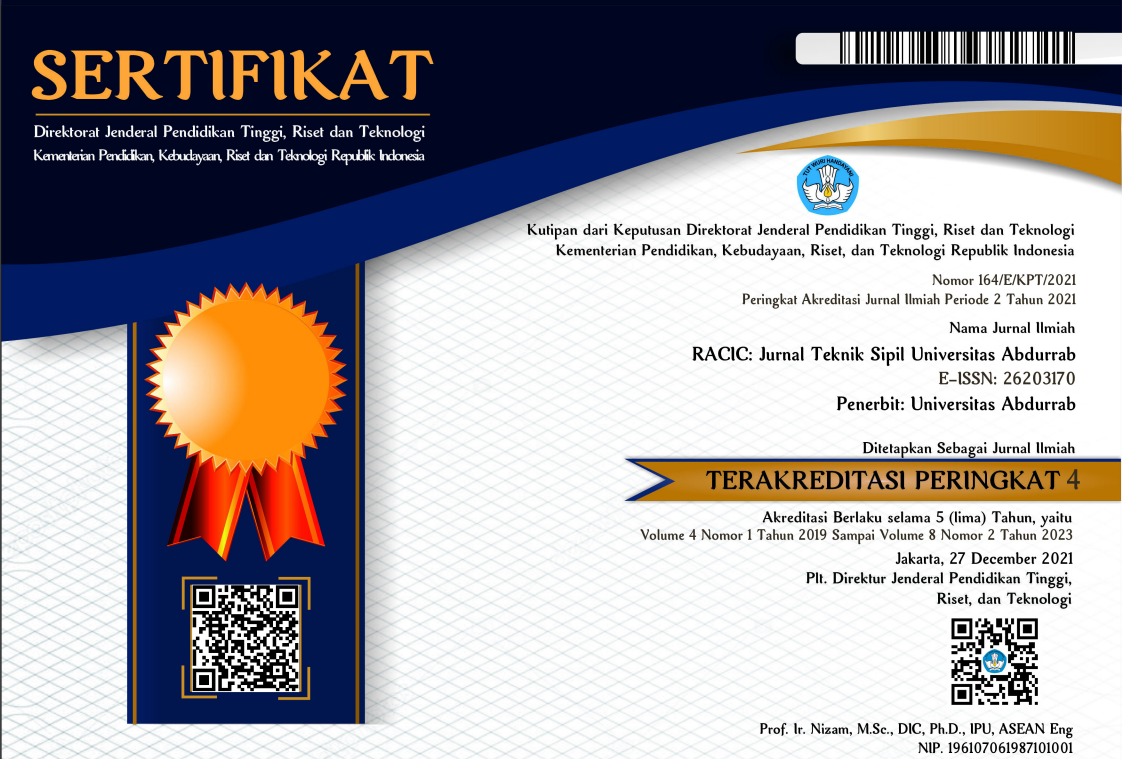ANALISA REOLOGI DASAR ASPAL MODIFIKASI NANO ABU CANGKANG SAWIT
DOI:
https://doi.org/10.36341/racic.v8i2.4216Keywords:
Keywords: Nano Palm Shell Ash (NACS), Basic Asphalt Rheology,Nano TechnologyAbstract
The development of asphalt modification using nano technology is one of the innovations in creating a new material that is nano meter scale that has a superior nature of large material. The uniqueness of the material nano is the smaller the size of the material, the surface area and performance of the material characteristics in the asphalt mixture are increasing. This study aims to determine the effect of the addition of nano ash of palm shells (NACS) on bitumen on the nature of the basic rheology of asphalt. Research methods use testing methods in the laboratory. The nano material used is a palm shell ash material obtained from the residual waste of the burning of the palm shell originating from Riau which is then processed into nano ash of the palm shell (NACS) in the ITB Chemical Laboratory. The asphalt used is asphalt Pen 60/70 Pertamina production. The use of NACS material in asphalt modification with variations of 1%, 2%, and 3%NACS can reduce penetration values, increase soft points, reduce ductility values and reduce mixing temperatures and compaction temperatures in line with increasing percentage of NACS ..
Keywords: Nano Palm Shell Ash (NACS), Basic Asphalt Rheology,Nano Technology
​
Downloads
References
Statistik Perkebunan Unggulan Nasional 2021-2023 Statistical Of National Leading Estate Crops Commodity 2021-2023.Direktorat Jenderal Perkebunan. 2023
Ramdhani, Fitra. The Evaluation of Mechanical Rheology on Rubber Asphalt Modification. In: Journal of Physics: Conference Series. IOP Publishing, 2020. p. 012080.
Ramdhani, Fitra; Rahman, Harmein; Subagio, Bambang Sugeng. Mechanistic Rheological Evaluation of Asbuton Modified Asphalt on Stiffness Modulus of Asphalt. In: Journal of Physics: Conference Series. IOP Publishing, 2021. p. 012090.
Ramdhani, Fitra; Tisnawan, Rahmat; Adly, Emil. Comparison of Fatigue Crack Resistance and Permanent Deformation to Asbuton Modified Asphalt and Rubber Modified Asphalt. In: 4th International Conference on Sustainable Innovation 2020–Technology, Engineering and Agriculture (ICoSITEA 2020). Atlantis Press, 2021. p. 80-82.
Subagio, Bambang Sugeng, et al. The rutting resistance and resilient moduli of Pre-Vulcanized Liquid Natural Rubber modified asphaltic concrete in warm-mix temperature condition. Journal of Civil Engineering and Management, 2022, 28.3: 196–207-196–207.
Subagio, Bambang Sugeng, et al. Stiffness Modulus of Asphaltic Concrete Wearing Course (AC-WC) Mix Containing RETONA BLEND 55®: Theoretical and Experimental Analysis. In: Proceedings of the Eastern Asia Society for Transportation Studies Vol. 7 (The 8th International Conference of Eastern Asia Society for Transportation Studies, 2009). Eastern Asia Society for Transportation Studies, 2009. p. 277-277.
Carlina, Serli; Subagio, Bambang Sugeng; Kusumawati, Aine. The Performance of Warm Mix for the Asphalt Concrete-Wearing Course (AC-WC) Using the Asphalt Pen 60/70 and the Sasobit® Additives. Civil Engineering Journal ITB, 2019, 26.1: 11-16.
Subagio, Bambang Sugeng, et al. Performance Evaluation Of Pre-Vulcanized Liquid Natural Rubber (Pvlnr) In Hot Mix Asphaltic Concrete. GEOMATE Journal, 2021, 20.78: 107-114.
Subagio, Bambang Sugeng, et al. Plastic Deformation Characteristics and Stiffness Modulus of Hot Rolled Sheet (HRS) containing Buton Asphalt (ASBUTON). In: Proceedings of the Eastern Asia Society for Transportation Studies Vol. 6 (The 7th International Conference of Eastern Asia Society for Transportation Studies, 2007). Eastern Asia Society for Transportation Studies, 2007. p. 262-262.
Syahputra, Deka; Subagio, Bambang Sugeng; Hariyadi, Eri Susanto. Asphalt Concrete–Wearing Course (Ac-Wc) With Crumb Rubber Mixture Performance Evaluation. Jurnal Teknik Sipil, 2020, 26.3: 223-230.
Sentosa, Leo, et al. Stiffness Modulus of Warm Mix asphalt (WMA) Using Asbuton and Synthetic Zeolite Additives. Geomate Journal, 2020, 19.75: 107-114.
W.J. Steyn, Applications of nanotechnology in road pavement engineering, in:Nanotechnology in Civil Infrastructure-A Paradigm Shift, Springer, Verlag Berlin Heidelberg, 2011, pp. 49–84.
Hornyak, Gabor L., et al. Introduction to nanoscience. CRC press, 2008.
LI, Ruoyu, et al. Developments of nano materials and technologies on asphalt materials–A review. Construction and Building Materials, 2017, 143: 633-648.
Enieb, Mahmoud; DIAB, Aboelkasim. Characteristics of asphalt binder and mixture containing nanosilica. International Journal of Pavement Research and Technology, 2017, 10.2: 148-157.
Jeffry, Siti Nur Amiera, et al. Mechanical performance of asphalt mixture containing nano-charcoal coconut shell ash. Construction and Building Materials, 2018, 173: 40-48.
Kurnia, Aztri Yuli, et al. Pemanfaatan Limbah Cangkang Dan Abu Tandan Sawit Terhadap Karakteristik Laston Wearing Course Dan Binder Course. Simposium II UNIID 2017, 2017, 2.1: 507-512.
Mukhlis, Mukhlis, et al. Kinerja Marshall Immersion pada Campuran Asphalt Concrete Wearing Course (AC-WC) dengan Penambahan Cangkang Sawit sebagai Substitusi Agregat Halus. Jurnal Ilmiah Rekayasa Sipil, 2018, 15.2: 99-105.
GINTING, Eko Noviandi. Pentingnya bahan organik untuk meningkatkan efisiensi dan efektivitas pemupukan di perkebunan kelapa sawit. WARTA Pusat Penelitian Kelapa Sawit, 2020, 25.3: 139-
Downloads
Published
Issue
Section
License
1. Copyright of all journal manuscripts is held by the RACIC : Rab Construction Research
2. Formal legal provisions to access digital articles of electronic journal are subject to the provision of the Creative Commons Attribution-ShareAlike license (CC BY-NC-SA), which means that RACIC : Rab Construction Research is rightful to keep, transfer media/format, manage in the form of databases, maintain, and publish articles.
3. Published manuscripts both printed and electronic are open access for educational, research, and library purposes. Additionally, the editorial board is not responsible for any violations of copyright law.
licensed under a Creative Commons Attribution-ShareAlike 4.0 International License.





